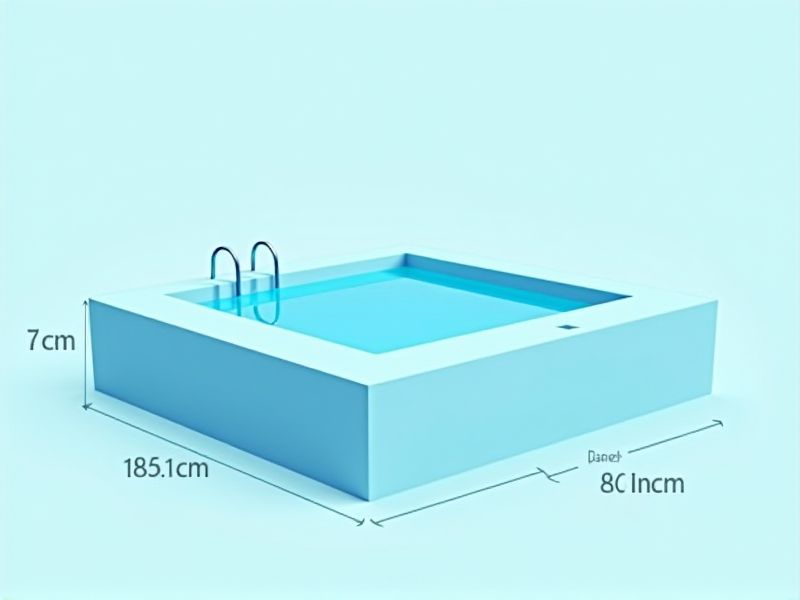
An Olympic-size swimming pool is designed to meet specific standards to ensure fairness and consistency in competitions. The standard dimensions are 50 meters in length, 25 meters in width, and a minimum depth of 2 meters. This size accommodates ten lanes, each 2.5 meters wide, allowing multiple swimmers to compete simultaneously. Knowing these measurements can help athletes, coaches, and facility planners ensure their training or events are aligned with international standards.
Length: 50 Meters
An Olympic swimming pool measures precisely 50 meters in length, providing a standard competition environment for elite athletes. This length is designed to accommodate various swimming events, from sprints to long-distance races. The pool's width is 25 meters, typically divided into 8 lanes, allowing for up to 8 competitors to race simultaneously. With a minimum depth of 2 meters, it ensures optimal conditions for performance and safety during high-intensity competitions.
Width: 25 Meters
An Olympic swimming pool measures exactly 25 meters in width, providing ample space for athletes to compete at the highest level. This standard sizing supports a total length of 50 meters, essential for all official swimming races. Equipped with eight lanes, each lane measures 2.5 meters wide, ensuring enough room for swimmers to perform without interference. The precise dimensions of an Olympic pool not only meet international competition standards but also enhance the spectator experience by delivering a thrilling environment for viewing elite performances.
Depth: 2 Meters Minimum
The standard depth for an Olympic swimming pool is a minimum of 2 meters, ensuring optimal conditions for competitive swimming. This depth reduces water turbulence, allowing athletes to perform at their best without the interference of waves. Proper pool dimensions also enhance the safety of divers and swimmers, minimizing the risk of injury. If you're designing a pool for competition, maintaining the 2-meter depth is crucial for meeting regulations and providing an effective training environment.
Number Of Lanes: 10
An Olympic swimming pool features a standard length of 50 meters and is uniquely designed with a total of 10 lanes. Each lane is 2.5 meters wide, allowing for ample space for swimmers during competitions. The pool's dimensions ensure compliance with regulations set by the International Swimming Federation (FINA), providing a uniform environment for athletes worldwide. With a minimum depth of 2 meters, the pool also minimizes wave interference, enhancing overall performance during events.
Lane Width: 2.5 Meters
An Olympic swimming pool must adhere to specific standards, one of which is the lane width of 2.5 meters, designed to provide adequate space for swimmers during competition. The total length of an Olympic pool is 50 meters, while the minimum width is 25 meters, accommodating a total of 8 to 10 lanes. This configuration not only enhances the swimmer's experience but also ensures fair competition by reducing water turbulence and interference from adjacent lanes. When planning for training or competitive events, understanding these specifications is crucial for optimizing performance in a standardized environment.
Water Temperature: 25-28°C
The standard water temperature for an Olympic swimming pool ranges from 25 to 28 degrees Celsius, ensuring optimal conditions for swimmers. Maintaining this temperature range is crucial for enhancing performance and minimizing muscle fatigue during competitions. The consistency of the water temperature impacts athletes' comfort and effectiveness in achieving their best times. As you prepare for competitions, being aware of these optimal conditions can help you tailor your training and expectations.
Starting Block Height: 0.5-0.75 Meters Above Water
The standard starting block height for Olympic swimming pools is set between 0.5 and 0.75 meters above the water's surface. This height is crucial for elite athletes as it allows for optimal launch angles and momentum during dives. Proper adherence to this standard ensures uniformity across competitive settings, facilitating equitable conditions for all swimmers. A well-designed starting block not only enhances performance but also prioritizes swimmer safety during events.
Turn Wall Height: 0.3 Meters At Minimum
The standard for Olympic swimming pools mandates that the turn wall height must be a minimum of 0.3 meters, ensuring consistent performance conditions for athletes. This specification promotes safety and effective training practices by providing a reliable structure for swimmers during turns. Olympic pools are designed to meet precise dimensions, measuring 50 meters in length and 25 meters in width, which facilitates high-level competitive events. Understanding these regulations is vital for any facility aiming to host official Swim events or provide training for elite athletes.
Pool Wall Thickness: 0.8-2.5 Meters
The standard for an Olympic swimming pool mandates a wall thickness ranging from 0.8 to 2.5 meters, ensuring structural integrity and safety. This thickness is critical for withstanding the significant pressure exerted by approximately 2.5 million liters of water typically contained in a standard 50-meter pool. The reinforced concrete construction not only enhances durability but also minimizes wave turbulence during competitive events. For your own pool designs or renovations, adhering to these specifications can significantly impact the overall performance and longevity of the facility.
Overflow Gutters For Wave Reduction
The standard size of an Olympic swimming pool is 50 meters in length and 25 meters in width, requiring precise engineering to maintain optimal conditions. Overflow gutters play a crucial role in minimizing wave formation, which can disrupt swimmers' performances. Designed to effectively capture wave energy, these gutters can reduce water movement by up to 30%, ensuring a smoother experience for athletes. When you consider the acoustics and further logistics of competition, investing in advanced wave-reduction systems is essential for achieving world-class standards.
